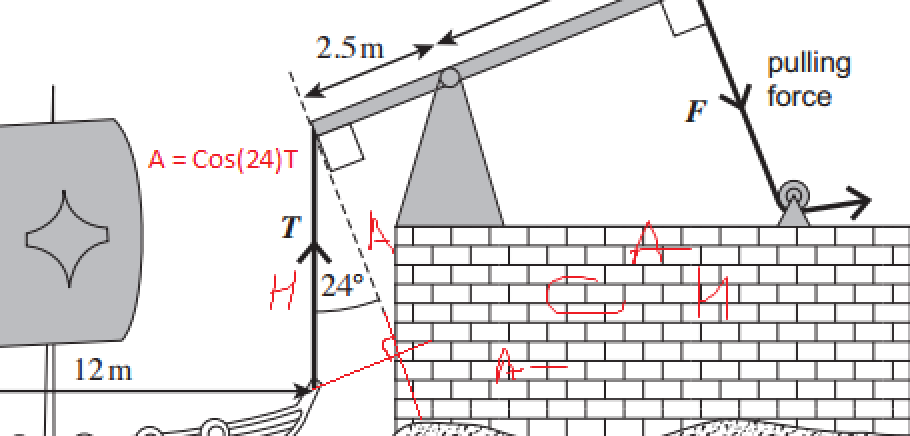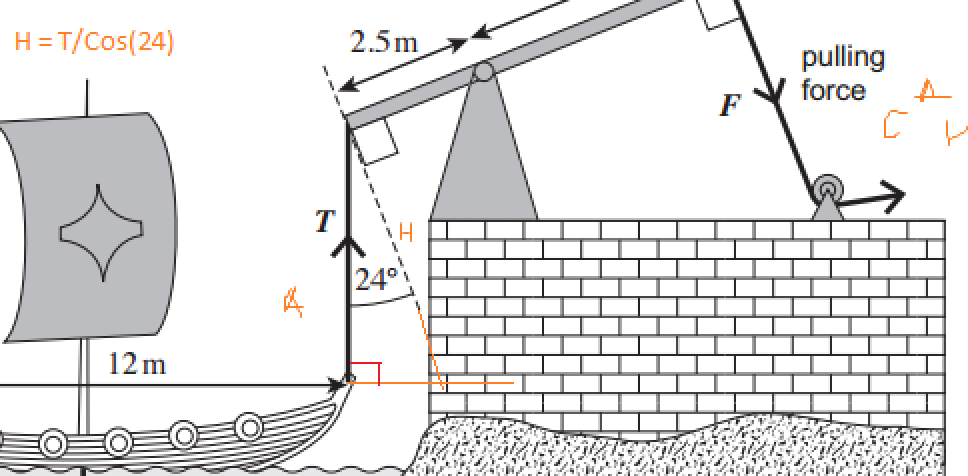Is there a reason why I can't resolve for the forces like this?
http://filestore.aqa.org.uk/subjects/AQA-PHYA2-QP-JUN14.PDF
Q(3)(a)(iv)
I understand I need to resolve the component of T that is perpendicular to the lever/rod/whatever the hell the thing is.
So initially I resolved like this (Which is correct according to the mark scheme)

But then I thought, surely if I just drew my triangle differently I could resolve like this too?

If anyone could explain why resolving it like the second picture won't work. that would be great. It's just that I don't want to be resolving incorrectly in the exam so I have thought of different ways to try and find the force.
Thanks!
Q(3)(a)(iv)
I understand I need to resolve the component of T that is perpendicular to the lever/rod/whatever the hell the thing is.
So initially I resolved like this (Which is correct according to the mark scheme)

But then I thought, surely if I just drew my triangle differently I could resolve like this too?

If anyone could explain why resolving it like the second picture won't work. that would be great. It's just that I don't want to be resolving incorrectly in the exam so I have thought of different ways to try and find the force.
Thanks!
Hi, as you said the first resolution is correct. The second one isn't correct because now T is no longer the hypotenuse. If you think about it, this means that you are saying the vertical component of T is bigger than T itself, which doesn't make sense. When resolving you need to make the force the hypotenuse Good luck with the exam 

Original post by TheBride
Hi, as you said the first resolution is correct. The second one isn't correct because now T is no longer the hypotenuse. If you think about it, this means that you are saying the vertical component of T is bigger than T itself, which doesn't make sense. When resolving you need to make the force the hypotenuse Good luck with the exam 

Ah I see now!
So does this mean that the force that the exam board labelled "T" is the RESULTANT force and the force I labelled in the first picture A, is the vertical component?
Thanks for the reply +rep
Original post by CrazyFool229
Ah I see now!
So does this mean that the force that the exam board labelled "T" is the RESULTANT force and the force I labelled in the first picture A, is the vertical component?
Thanks for the reply +rep
So does this mean that the force that the exam board labelled "T" is the RESULTANT force and the force I labelled in the first picture A, is the vertical component?
Thanks for the reply +rep
Yes A is the vertical component of T, T is the actual force causing the horizontal and vertical components, but be careful of saying "resultant" because that's used more for adding/subtracting different forces . Also thanks for the rep!
 Also just quickly although I said "vertical" in this case it's actually at a slight angle- but you get the gist!
Also just quickly although I said "vertical" in this case it's actually at a slight angle- but you get the gist!(edited 7 years ago)
Original post by TheBride
Yes A is the vertical component of T, T is the actual force causing the horizontal and vertical components, but be careful of saying "resultant" because that's used more for adding/subtracting different forces . Also thanks for the rep! 

Thanks again!
Quick Reply
Related discussions
- A level maths mechanics moments and forces question
- Further Mechanics 1 Question
- Maths Mechanics
- Force Diagram (A2 Edexcel)
- Tension in a Simple Pendulum
- maths a level mechanics question
- Urgent Resultant force maths question plsss help!!
- Friction Question Help
- m1 june 2002 paper
- Physics question circular motion
- AQA A Level Mathematics Paper 2 (7357/2) - 13th June 2023 [Exam Chat]
- Understanding physics #1
- Friction question
- Confused about "motion to a vertical plane" questions
- Public International Law Problem Question Structure
- don't understand force exerted by A on B
- alevel mechanics moments help
- Why is tension not equal to weight in moments questions?
- mechanics 1 math
- A level maths mechanic question
Latest
Last reply 1 minute ago
If I drop a subject, do I have to submit the grade to UCAS still?Last reply 1 minute ago
i'm struggling at uni and i genuinely have no idea what to doLast reply 1 minute ago
Civil Service Fast Stream 2024 - Applicants threadLast reply 1 minute ago
BAE systems degree apprenticeships September 2024Last reply 2 minutes ago
Official: University of Manchester A106 2024 Entry ApplicantsMedical Schools
1252
Last reply 2 minutes ago
Official University College London Applicant Thread for 2024Last reply 2 minutes ago
Software Engineering Degree Apprenticeship | Digital & Technology Solutions Level 6Last reply 3 minutes ago
Medical doctor degree apprenticeship 2024Last reply 4 minutes ago
University exams start in 10 days, losing the will to liveLast reply 4 minutes ago
Are awards in Intermediate challenges (achieved in Y11) worth mentioning on PS?Last reply 9 minutes ago
KPMG Audit Apprenticeship 2024Last reply 11 minutes ago
Official: University of Bristol A100 2024 Entry ApplicantsLast reply 12 minutes ago
JK Rowling in ‘arrest me’ challenge over hate crime lawLast reply 13 minutes ago
Official University of Edinburgh Offer Holders Thread for 2024 entryLast reply 15 minutes ago
Official: University of Leicester A100 2024 Entry ApplicantsLast reply 17 minutes ago
can any people who are studying at exeter's penryn campus please answer this?



